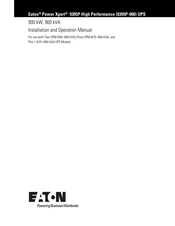User Manuals: Eaton Power Xpert 9395P-900 Series UPS
Manuals and User Guides for Eaton Power Xpert 9395P-900 Series UPS. We have 2 Eaton Power Xpert 9395P-900 Series UPS manuals available for free PDF download: Installation And Operation Manual
Eaton Power Xpert 9395P-900 Series Installation And Operation Manual (232 pages)
High Performance UPS
Table of Contents
Advertisement
Advertisement
Related Products
- Eaton Power Xpert 9395P-900 Two UPM
- Eaton Power Xpert 9395P-900 Two UPM Plus 1 FI-UPM
- Eaton Power Xpert 9395P-900 Three UPM UPS Plus 1 FI-UPM
- Eaton Power Xpert 9395P
- Eaton Power Xpert 9395P 250 kVA
- Eaton PowerXpert 9395P-600/400
- Eaton PowerXpert 9395P-600/250
- Eaton PowerXpert 9395P-600/200
- Eaton 9395P-600
- Eaton Power Xpert 9395P-1200/750

